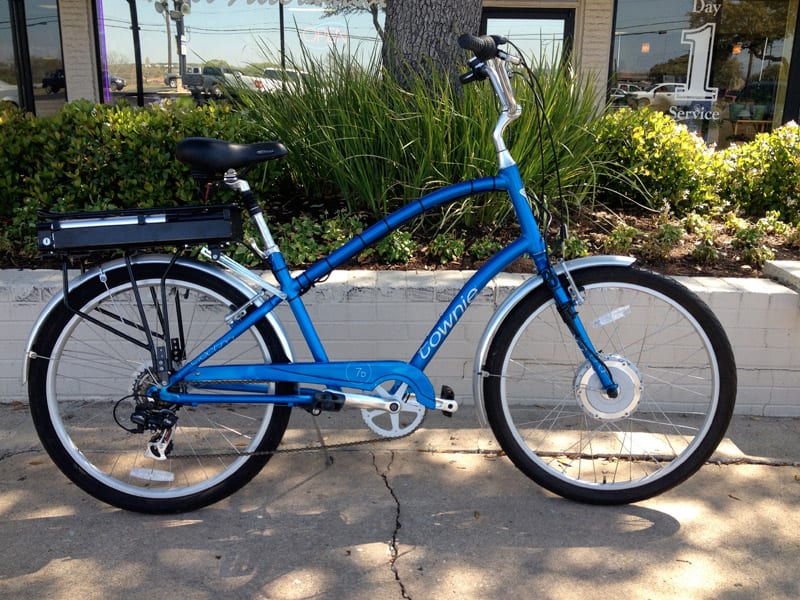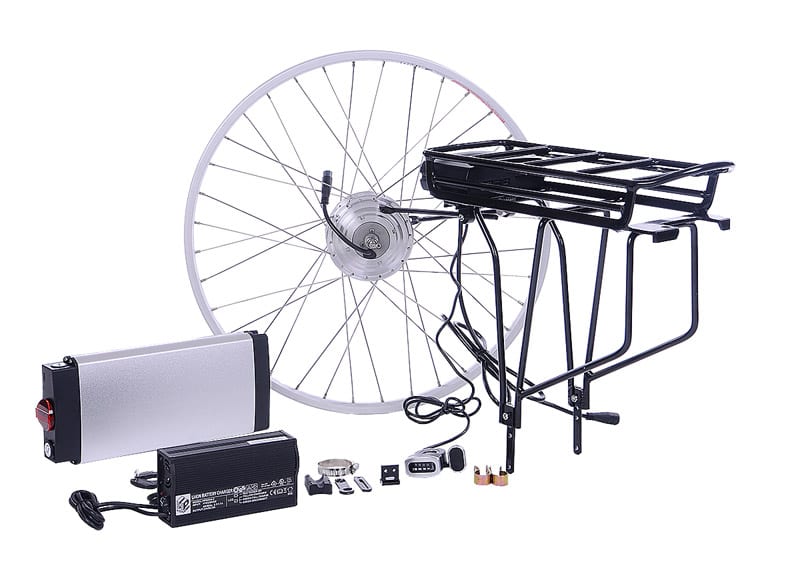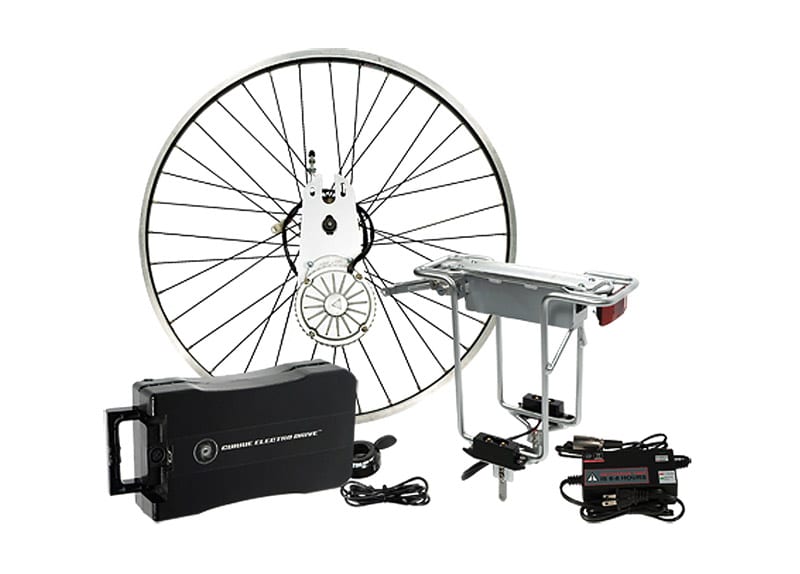The Currie Electro-Drive bike kits can be a little confusing at first. You may notice they go by several names: Currie Electro-Drive bike kits 1-4 and also Currie Conversion Kit 2700, 3700 and 4700 (just think of those last three as Kit 2, 3 and 4 respectively). These kits consist of the same motors, batteries and controllers that power the fully assembled eZip and IZIP electric bike lines made by Currie Technologies. Overall they are effective, durable and proven but somewhat limited by comparison to fully assembled kits because they lack pedal assist (PAS) modes. If you mount one of these on your bike you will only be able to use a thumb throttle to activate the system. Considering the variety offered by these kits, they can be a great product for those who already have a bike they love and are just looking for a little boost but they aren’t perfect.
So what’s the difference between the four kits? Somewhat confusingly, they go from 1 to 4 but the fourth kit would make more sense being called 1.5 because it uses the same basic sealed Lead acid SLA battery as kit 1 but introduces a nicer hub motor instead of a chain drive motor which is louder and less efficient. You can check the specs above for the exact details but think of it like this: kit 1 and 4 have heavy Lead acid batteries, kit 2 has a nicer Lithium-ion battery that will endure more than twice as many charge cycles before wearing out and kit 3 is the top of the line with a larger Lithium-ion battery and a larger 500 watt motor! This kit actually resembles the IZIP E3 Zuma which is one of my favorite ebikes around.
Now that you’ve got some idea of how to sort these kits out and determine which one might be best for your budget and ride, let’s talk about some of the features. While each kit looks a little different, they all follow a layout. You get a bolt-on rack that mounts like any other rack to the rear end of your bike. Make sure your bike has eyelets to accept a rack before ordering one of these kits! The pictures here show an Electra Townie which works very well and even served as the inspiration for Pedego’s Classic Cruiser and Electra’s own Townie Go.
Whichever bike you’ve go I recommend considering the saddle and tires carefully because they can do a lot to smooth out the ride. You’ll notice that most ebikes have larger balloon tires and wider sprung seats. This is because they go fast and can cause a lot of vibration for the rider. Also, many electric bikes don’t have shocks which helps to keep their cost low and make them stiff and durable under the increased load of batteries, controllers and motors. Adding 20 to 30 pounds to any bike will change its handling and because these kits all put the battery on the back, a front shock may not do as much to smooth it out as you’d think and a rear shock may get overloaded with the increased weight and not perform as expected. Long story short, think about the weight and how your bike will respond.
On to the motors! Kit 1 offers a 450 watt chain drive motor that is kind of a wildcard in the world of ebikes. You can see this thing in action on the eZip Trailz. I always figured they made it extra powerful to haul around those 18 pound Lead acid batteries… but the chain drive itself is less efficient and having the motor out to the side creates some imbalance on the bike overall. It’s a unique system and you could actually buy a fully assembled Trailz for almost the same price. Kit 2 and 4 use the same 250 watt brushless geared hub motor that can be found on the IZIP E3 Vibe. This is a solid motor that runs smooth and provides good torque but not enough for larger riders or steep hills. It’s meant for around town riding. Kit 3 is where the real power is at and this 500 watt brushless geared hub motor offers great torque and speed.
The wheels for each of these kits only come in 26″ which is standard for most mountain bikes but a bit small for city and road bikes that usually use 700c / 29″. Currie has opted for a front wheel design for kits 2, 3 and 4 to make it easier to mount onto your bike and while this does help to distribute the weight more evenly across the frame, it does put more stress on a part of your bike not normally meant to handle such weight and force. For this reason each of these kits also includes a torque arm that distributes force upwards into the fork, away from the drop outs where the bolt goes through. While torque arms do help, think carefully about using one of these kits on a carbon fork or one with a built in shock as they may break under the increased pressure. The wheel that comes with kit 1 is designed to replace the rear wheel and this makes it sturdier but also adds a lot of extra weight to the back of the bike and makes it much harder to install.
All things considered here, these kits are a neat offering from a company that is primarily focused on selling fully assembled electric bikes. They went to a lot of trouble to build these custom thumb throttles, change the stock rear wheel designs to work with front wheels and create new bolt on racks for the larger battery packs. I’d like to see these be a little less expensive considering the low cost of their fully assembled bikes but they probably do less volume. I’m not a huge fan of bolt-on racks because they get rattly over time if you don’t keep them tight but if you’re the one who built the bike you probably have the energy, awareness and skills to keep it going. Bottom line, if you’ve tried one of Currie’s eZip or IZIP bikes and enjoyed it but have your own frame and want to tinker around with making it electric these kits could be a lot of fun.
Pros:
- Diverse selection of kits that work on front or rear wheel
- Rear rack on kit 2 and 3 use the same gauge tubing as normal bike racks and work well with panniers
- Front wheel design with kit 2, 3 and 4 are easy to mount
- Thumb throttle works well and includes a power gauge on kits 2, 3 and 4
- All kits include lock and key to secure battery pack
- Batteries are easy to replace or upgrade through Currie
- Kit 1 and 2 can support two batteries at once to extend range with double side mount option on rear rack
Cons:
- Wheel sizes only come in 26″
- Rear rack battery mount can come loose and get rattly over time
- Kit 1 wheel design is harder to mount since it replaces the rear wheel
- Overall these kits are pretty expensive, especially compared with a fully assembled eZip or IZIP electric bike
- No pedal assist option only thumb throttle
- Wires can be a bit tacky and hard to deal with, look nicer when run through frame but that’s not easy with a stock bike and may even compromise structural integrity
- No lights included or built in with these kits
- No fancy computer console to tell you how fast or far you’re going
Resources:
- Official Site: http://www.currietech.com/
- More Pictures: https://goo.gl/photos/ezaX9ktWPzhWbeeDA















Larry Pizzi says
Hi Court,
Just a note of update, all Currie Electro-Drive kits are now available in both 26′ and 700c wheel sizes. Also all parts are available separately with many more custom options to come in the very near future. Stay tuned and let us know if you have any questions. Thanks!
Larry
[email protected]